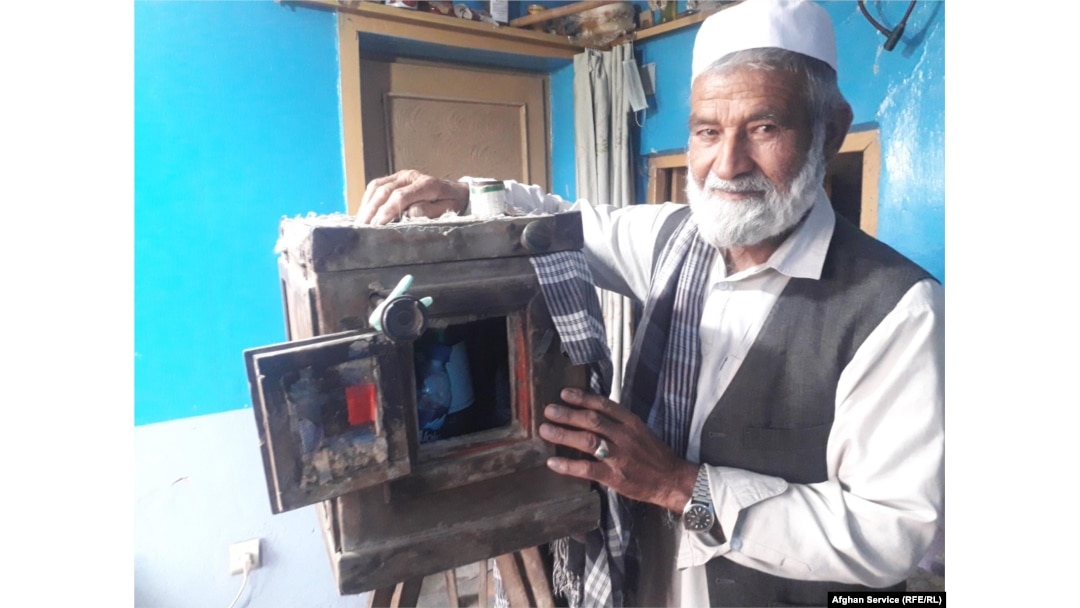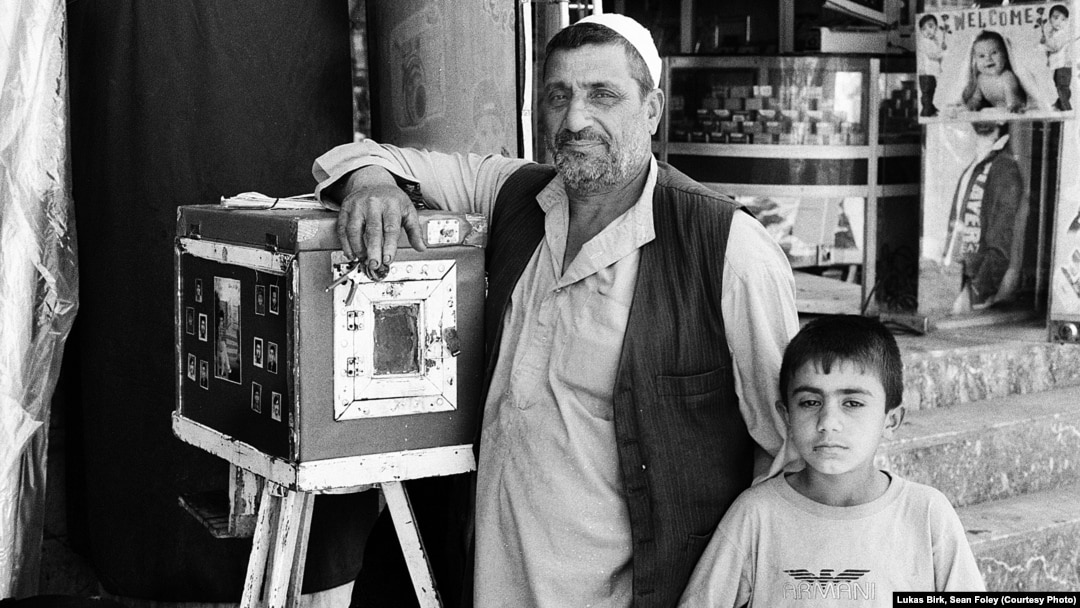Seventy-year-old Haji Mirzaman laments as he fiddles with the wooden door on a beloved box camera he has used for 55 years.
Just over a decade ago, he was one of dozens of photographers who still made a living in Kabul by shooting portraits with the primitive Afghan box camera, known in Dari as a "kamra-e-faoree," or "instant camera."
Their 19th-century artisan skills transformed the bulky wooden contraption into both a camera and a self-contained darkroom where they could produce black-and-white photos within minutes -- first by making a paper negative and then by photographing the negative to create a positive image.
The century-old know-how, photographic instincts long forgotten in the West, survived Taliban rule in the 1990s, when taking photos of any living creature was forbidden.
But now, the box camera is on the brink of disappearing from Afghanistan -- replaced by digital photography, modern studios, and smartphone selfies.

Haji Mirzaman, Kabul's last professional box-camera photographer.
Mirzaman is the last kamra-e-faoree photographer still working in Kabul -- and possibly in Afghanistan.
In semiretirement, with his old studio closed, he now works only by appointment.
He shoots about 30 portraits a year in the courtyard outside his home, where the sun serves as his lighting.
"Who else still uses the kamra-e-faoree? Nobody uses these cameras anymore," Mirzaman tells RFE/RL sadly.
"There used to be a lot of these cameras here, more than 500 of them," Mirzaman says. "Now, with photography digitized, the karma-e-faoree has disappeared."
He says the spare parts and the right type of photo paper are nowhere to be found.
"I am the last because I still have the materials and some of the photo paper, which isn't made anymore," Mirzaman says. "But my supply of paper is 20 years old. I have only a little left. When it is gone, I will say, 'God bless you.'"
Museum Dream
In the western Afghan city of Herat, 50-year-old photographer Hekmatullah Arbabzadeh also regrets the disappearance of the kamra-e-faoree from Afghan culture.
An avid photographer since he was 13, Arbabzadeh learned how to use the box camera from an elderly master in the early 1980s.
But he also can no longer find the special photo paper once produced abundantly in India, Russia, and China.
"Photography is important to me," Arbabzadeh tells RFE/RL. "I do not want this art to disappear. But now everyone has turned to digital photography. Everyone thinks photography is something they do with their mobile phones."
Kabul-based photographer Abdul Samad in the late 1950s with his box camera.
Arbabzadeh hopes his collection of antique cameras and darkroom equipment will one day form the heart of a photography museum in Herat.
He describes his two Afghan box cameras as "the early roots" of photography -- saying he wants to preserve "the art of the kamra-e-faoree" for future generations.
"It is not just about taking photos," he says. "It's the culture and nature of photography -- how it flourished in the past and evolved, who came out of this art, the expressions they used, and how the old tools worked."
Arbabzadeh notes that Afghan box cameras have only one fixed lens without a shutter. To take a picture, the lens cover must be removed by hand for a few seconds on a sunny day or up to 40 seconds when it's cloudy.
"Developing paper negatives in a darkroom that is inside a box, the same box that is the camera – this requires a special love of photography" and dexterity, he says.
The photographer had to rely on his own skills for everything, he says, “calculating the light and exposure in his mind.”
"Sometimes, a person having their photo taken would think the photographer was mentally ill because he would move his lips," Arbabzadeh laughs. "But he was simply counting the seconds under his breath so the exposure time wouldn't differ from one photo to another."
"In fact, the old Afghan photographers had a timer on their tongues," he says.
The focusing plate inside an Afghan box camera.
Arbabzadeh believes that if someone wants to study an art form, they must "learn the old principles that form the roots of the art."
He says his hope for a museum is “to introduce young photographers to these old ways.”
Disasters Of War
The world's most famous image from an Afghan box camera is from February 1993: the only known portrait of the one-eyed future leader of the Taliban, Mullah Mohammad Omar.
Khalid Hadi was 12 years old when he took the black-and-white photo of Mullah Omar while working to document recipients of financial support from an Islamic relief foundation in Kandahar.
Mullah Omar was just one of 10,000 wounded mujahedin fighters and civilian war victims that Hadi photographed from 1992 to 1994.
Hadi later became the Taliban's official photographer, a job belying the notion in the West that Mullah Omar had banned all photography in Afghanistan.
In fact, Mullah Omar had declared that it was forbidden to photograph any living creature.
Hadi photographed construction work and other infrastructure projects for the Taliban. But by 1997, dismayed by the brutality of the Taliban regime that he witnessed, Hadi left Afghanistan for the United States, where he still lives today.
In April, Vienna-based Fraglich Publishing released a book containing some of Hadi's other box-camera photos from Kandahar. It is titled Disasters Of War: Portraits By Khalid Hadi.
Disasters Of War: Afghan Box-Camera Portraits By Khalid Hadi
Fascinated Foreigners
Western photojournalists who worked in Afghanistan shortly after the collapse of the Taliban regime were fascinated by the Afghan photographers who brought their box cameras out of hiding to shoot portraits on the streets again.
Rick Loomis, a Pulitzer-Prize-winning Los Angeles Times photographer, told RFE/RL in February 2002 that he was amazed by the skills and knowledge of a street photographer named Rohullah who was working near Kabul's storied Chicken Street at the time.
Loomis took lessons from Rohullah and bought an old kamra-e-faoree from him, packing it into a metal container and shipping it back to his home in California.
"I felt guilty about it at first because I thought he wouldn't be able to do this kind of work anymore," Loomis said. "But he told me it was easy for him to get another box camera."
Rohullah did get another box camera, and he continued to work as a street photographer in Kabul for another decade.
But he quit in 2012 to open a grocery store after the government started requiring color photographs for ID cards -- a decision that hurt business for all of Afghanistan's box-camera photographers.
Irish ethnographer Sean Foley and Austrian photographer Lukas Birk also were fascinated by the kamra-e-faoree photographers they saw during their repeated visits to Afghanistan from 2002 to 2012.
Birk and Foley co-authored a book in 2013 called Afghan Box Camera. They also launched an online archive about Afghanistan's photographic history and culture called The Afghan Box Camera Project.
Birk says it was clear to him in 2005 that the kamra-e-faoree would soon disappear. He said his goal was to try to "understand, record, and bring back to life how photographers in Afghanistan were still practicing a 19th-century way of taking photographs."
A short documentary film released in 2012 by the Afghan Box Camera Project documented the entire process of a portrait being taken by one of Kabul's last street photographers.
"What struck us as foreigners coming to Afghanistan in 2002 and 2005 was seeing this box camera still widely used," Birk tells RFE/RL.
He says it was rare anywhere in the world, at that time, to see this form of photography still being practiced – although they also found Afghan box-camera photographers in Peshawar, Pakistan.
"Photography to them was very different than what it is to me -- an ancient way of working that requires such an enormous amount of skills," Birk explains.
Birk says he gained many perspectives from the Afghan box-camera photographers he met: lessons on how they used materials, how they mixed their own developer and fixer from powder chemicals, how they gauged the weather and calculated time, and the special way that they "thought about photography."
Documenting History
Through interviews with dozens of elderly Afghan photographers, many who have died during the past decade, Birk and Foley documented the historical rise and fall of the Afghan box camera.
Birk says it began in Europe and the United States during the 1890s with a camera that produced a negative directly on paper.
Izzat Ullah taking a family photograph in Peshawar, Pakistan, in 2012.
Simple to build, it spread to villages across the world – from Eastern Europe and Latin America to the farthest reaches of British Colonial India, where it became popular in the 1910s.
"We think this box camera moved into Afghanistan from the Indian subcontinent in the early 20th century," Birk says.
Birk and Foley learned that one box-camera design spread to every Afghan province because of a decision in the 1950s by Afghanistan's king, Zahir Shah, to introduce a black-and-white photo ID card for all male citizens.
"Zahir Shah looked for people who could facilitate photography in every village," Birk explains.
He says a carpenter was hired in the 1950s who made copies of one old box camera that had reached Afghanistan years earlier.
These were provided to a "small army of photographers who branched out with scribes into the furthest reaches of Afghanistan to document the male population with photographs for the first time," he says.
Those box cameras were then copied by other carpenters. Kabul-based photographers like Abdul Samad traveled to the provinces to train a new generation how to use them from the late 1950s into the 1970s.
Ghulam Rasoul, a retired 75-year-old box-camera photographer from Ghor Province, says that's how he was trained more than 50 years ago.
Ghulam Rasoul was trained more than 50 years ago as Ghor Province's first photographer.
"I was the first photographer in Ghor Province who was working on the ID cards that were distributed during the era of Zahir Shah," Rasoul tells RFE/RL. "Then I was called to Farah Province with a delegation from the Interior Ministry. I photographed there for years to distribute IDs."
Mirza Dost Mohammad, an 80-year-old former director-general of Ghor's Population Registry, confirms Rasoul's importance as the government's first official photographer there.
"If Ghulam Rasoul had not been a photographer, the ID card was not considered valid," Mohammad tells RFE/RL. "If it were not for his photos, the ID cards would not have been issued."
Birk says it's incredible that one decision in the 1950s by Zahir Shah launched an administrative process that "changed the way photography was practiced and spread through Afghanistan."
He says that left a legacy in which the same model of box camera remained the tool of the trade across the country into the 21st century.
Although the kamra-e-faoree is no longer used by Afghan photographers to earn their daily wages, Birk says there are many photography enthusiasts outside of Afghanistan trying to keep the traditions alive.
He says hundreds have downloaded plans from the Afghan Box Camera Project to build their own kamra-e-faoree.
Written and reported by Ron Synovitz with reporting by Mustafa Sarwar and RFE/RL's Radio Free Afghanistan



